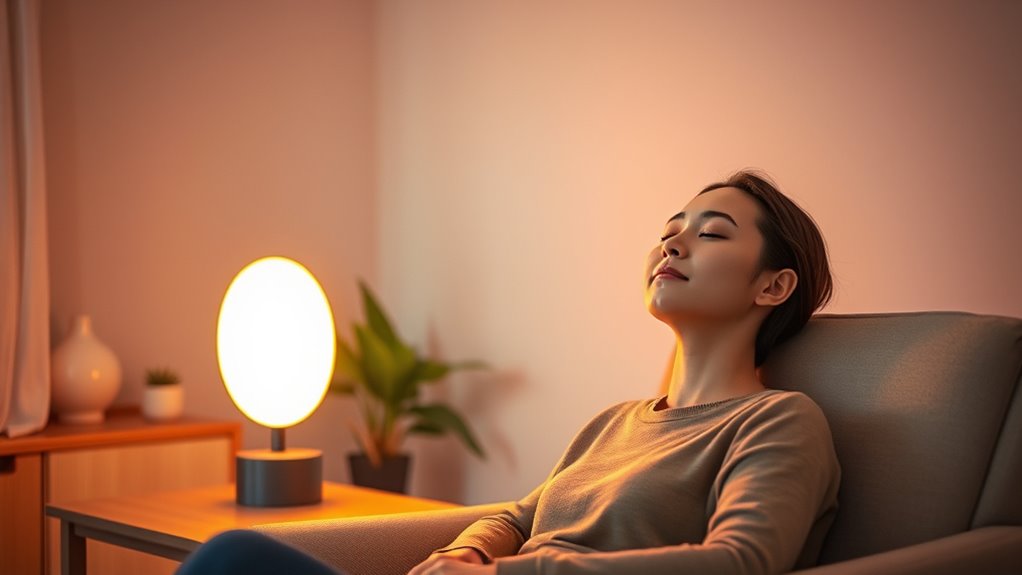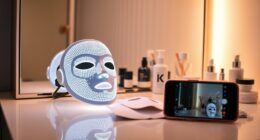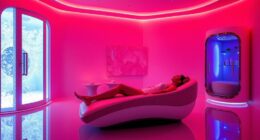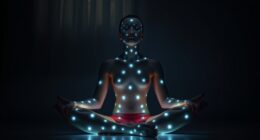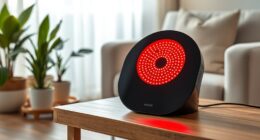To effectively balance your mood and sleep with light therapy, follow proven protocols like using a 10,000 lux light for 20-30 minutes in the morning. Be consistent with your sessions daily, ideally in a comfortable environment free from glare. Tailor the timing and duration as needed, and consider consulting a healthcare professional for personalized guidance. Staying patient and regular helps maximize benefits—if you keep up, you’ll discover more ways to enhance your mental wellness.
Key Takeaways
- Follow proper protocols, including 20-30 minute sessions with 10,000 lux in the morning, tailored to individual needs.
- Consistent daily use helps regulate circadian rhythms, improving mood and sleep quality over time.
- Use light therapy in a distraction-free environment for maximum effectiveness and adherence.
- Consult healthcare professionals to customize protocols and ensure safety, especially with underlying health conditions.
- Combining light therapy with routine adjustments supports sustained mental wellness and better sleep balance.
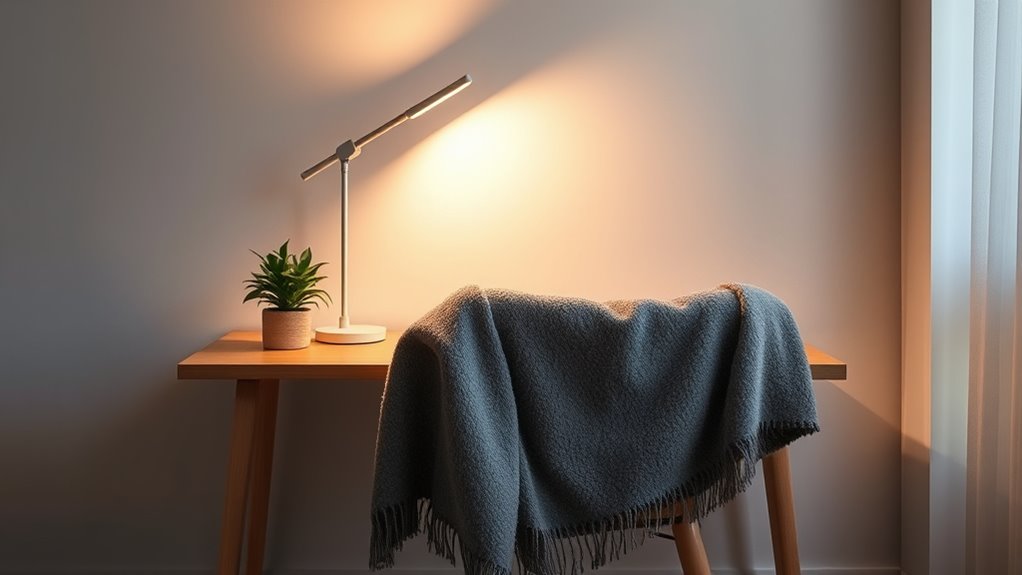
Light therapy has emerged as a promising, non-invasive treatment for improving mental wellness, particularly for those dealing with seasonal affective disorder (SAD) and other mood-related conditions. When you start exploring light therapy, understanding the importance of proper light therapy protocols becomes essential. These protocols guide how often, how long, and at what intensity you should use the light box to maximize benefits and guarantee safety. Typically, sessions last between 20 to 30 minutes in the morning, with a light intensity of around 10,000 lux, but it’s important to tailor these guidelines to your specific needs. Consistency is key; sticking to a daily routine helps your body adjust to the light exposure, leading to more noticeable improvements in mood and sleep patterns. Over time, following proven light therapy protocols can markedly enhance your mental health benefits, reducing feelings of depression, anxiety, and fatigue.
As you incorporate light therapy into your daily routine, you may notice its positive effects on your mental state and overall well-being. The mental health benefits of light therapy extend beyond just mood elevation; it also helps regulate your circadian rhythms, which are essential for restful sleep and alertness during the day. Proper use of light therapy can help reset your internal clock, alleviating issues like jet lag or irregular sleep schedules, which often contribute to mood disturbances. When you adhere to established light therapy protocols, you’re more likely to experience consistent improvements, making it easier to manage and even prevent episodes of depression linked to seasonal changes. It’s important to use your light box in a space free from glare and distractions, guaranteeing you’re fully exposed to the light without strain or discomfort.
You should also consider any underlying health conditions or medications that might influence how you respond to light therapy. Consulting with a healthcare professional can help you optimize your light therapy protocols, ensuring safety while maximizing mental health benefits. Remember, this treatment isn’t a quick fix; it requires patience and regularity. Over time, the cumulative effects of consistent light therapy sessions can lead to sustained mood improvements and better sleep quality. As you become more familiar with your personal response, you can adjust the timing or duration of your sessions for even greater benefits. Ultimately, integrating proper light therapy protocols into your routine empowers you to take control of your mental wellness naturally and effectively, helping you feel more balanced and energized every day.
Frequently Asked Questions
Can Light Therapy Replace Medication for Depression?
Light therapy can be effective for some people with depression, but it usually doesn’t replace medication entirely. Its effectiveness varies, and for moderate to severe depression, medication often provides more reliable relief. You might consider light therapy as a complementary treatment or for mild depression. Always consult your healthcare provider to compare its effectiveness with medication and develop a personalized plan for your mental wellness.
Is Light Therapy Safe for Children and Teens?
Light therapy can be safe for children and teens when used properly, but pediatric safety and developmental impact are important considerations. Studies show that with supervised use, side effects are minimal, making it a promising option for young people. However, you should always consult a healthcare professional to guarantee the therapy is appropriate, especially for developmental concerns. Proper guidance helps maximize benefits while minimizing risks for your child’s mental wellness.
How Long Does It Take to See Results From Light Therapy?
You may start noticing timing expectations for light therapy results within a few days to a couple of weeks. Individual responses vary, so some people see improvements sooner, while others may take longer. Consistency is key; using the light therapy device daily as directed helps speed up the process. Keep track of your mood and sleep patterns to gauge progress, and consult your healthcare provider if you don’t notice changes after several weeks.
Are There Any Side Effects From Using Light Therapy?
You might find light therapy has some side effects, but they’re usually manageable. Be aware of photosensitivity risks, which can cause skin or eye irritation, and eye safety concerns if you don’t use the device properly. It’s not a walk in the park for everyone, so follow instructions carefully. If you experience headaches, eye strain, or skin issues, stop and consult a healthcare professional—better safe than sorry!
Can Light Therapy Be Used Alongside Other Mental Health Treatments?
Yes, you can use light therapy alongside other mental health treatments. It often works well as a complementary approach, enhancing the effects of medication or therapy. Make sure to discuss your plan with your healthcare provider to guarantee proper lifestyle integration, like timing sessions for maximum benefit. Combining treatments can boost your overall wellness, but professional guidance helps you avoid potential interactions or side effects.
Conclusion
By incorporating light therapy into your routine, you might find it’s more than just a mood booster—some studies suggest it can genuinely regulate your circadian rhythms, improving sleep and mental clarity. While the science is promising, it’s worth questioning whether the benefits come from the light itself or the placebo effect. Either way, giving light therapy a try could offer a simple, natural way to enhance your mental wellness, provided you stay attentive to how your body responds.
